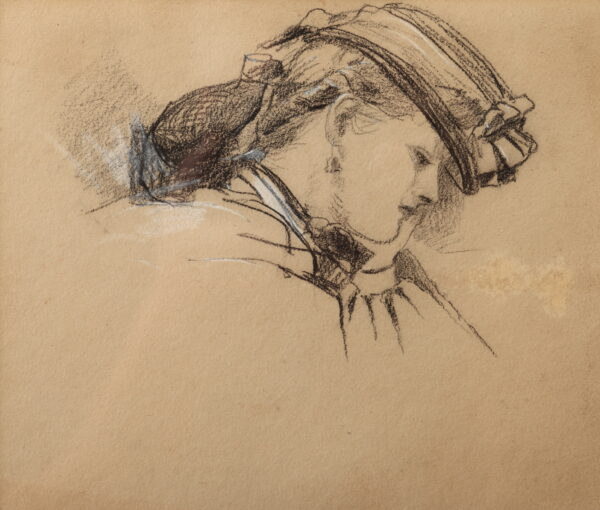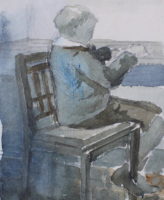Born in Boston, Massachusetts in 1836 and growing up in Cambridge, Winslow Homer became one of the all-time leading figures in American art, known for his marine genre paintings and for his espousing of realism, especially of American life. From the 1880s until his death in 1910, his work was focused on issues of mortality and the forces of nature such as violent storms at sea. Between 1884 and 1889, he did numerous etchings of his own paintings and watercolors.
Homer had no formal artistic training until he was apprenticed to a lithographer, J.H. Bufford, but Homer disliked lithography and got work as an illustrator for Ballou’s Pictorial. From 1859 to 1883, he worked from New York for Harper’s Weekly, and from October 1861 to May, 1862, was one of their Civil War illustrators. He served as a special correspondent to cover the outbreak of the War, and attached to the Army of the Potomac, and filled his sketch book with informal studies of uniforms, weapons and the daily activities of the individual soldiers. From this period, he gleaned subject matter that ultimately became some of the outstanding paintings of the Civil War.
He also studied at the National Academy of Design where Frederick Rondel was a major influence, but during the early years of his career, illustration was his “bread and butter.”
After the Civil War, he traveled and studied in Europe for several years including France from 1866 to 1867, where he shared a studio in Montmartre with fellow artist Albert Warren Kelsey. Several small paintings are extant from that period as are the three illustrations for Harper’s Weekly that had helped to finance his trip.
He returned to New York and settled for thirteen years in New York where his studio proximity to that of Eastman Johnson, genre painter, was a major influence. Many of Homer’s early New York paintings were of leisurely figures in landscape, reflecting his time in France influenced by the Impressionists. For much of his residency in New York, he lived and worked in the famous Tenth Street Studio Building, and became increasingly exploring in his subject matter–rural life, childhood remembrances including summers at Lake George, Saratoga Springs, and the Adirondack Mountains. One of his most famous paintings, Snap the Whip from 1872, owes much to French plein-air painting and to the genre style of William Sidney Mount. In 1873, he began working in watercolor, and many of his most acclaimed works are in that medium.
From 1881 to 1882, he was in England near Tynemounth on the rugged coast of the North Sea at the small fishing village of Cullercoats, and he began doing scenes, harsher in tone, of figures struggling heroically in landscape. There he worked almost exclusively in watercolor.
Settling permanently in the seclusion of Prout’s Neck, a remote area on the coast of Maine, he strove not only for solitude but for the closest approximation he could find in the United States to that same English coast. At Prout’s Neck, he was able to indulge his love of the outdoors, his fascination with the moods of the weather and the people in the landscape. He traveled all over for seascapes, boating, and sporting scenes and also made several trips to Caribbean Sea locations including Bermuda, the Bahamas and Cuba, where he did a number of marine scenes ominous in tone.
Homer never married and in his most productive years lived a highly secluded life, seemingly content according to his letters and family accounts. In 2004, the Portland Museum of Art in Portland, Maine began a two-year campaign to raise 12 million dollars for acquisition, preservation and endowment of Homer’s studio at Prouts Neck.
The Associated Press reported that on May 5, 1998, Bill Gates, Chairman of Microsoft Corporation, paid $30 million for Lost on the Grand Banks, the last major seascape by Winslow Homer still in private hands. The price paid at a secret private sale is easily a record for American art according to The New York Times, citing anonymous art experts. The ‘Times’ had the following:
“The seller, John Spoor Broome, a businessman from Southern California, would not discuss the price or buyer. Broome bought “Lost on the Grand Banks” from his grandmother in the 1940s. The painting measures nearly 32 by 50 inches and portrays a dramatic image from 1885 of two fishermen in a choppy sea peering over the side of their small boat. ”
Sources: AskArt:
Michael David Zellman, 300 Years of American Art
Matthew Baigell, Dictionary of American Art
Peter Falk, Who Was Who in American Art
Art-Talk, November-December 2004
Associated Press, May 1998


